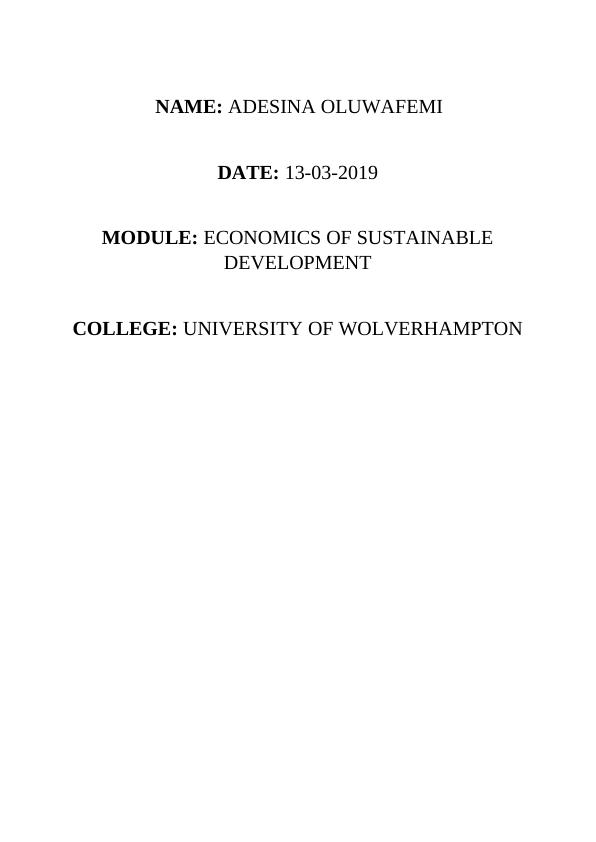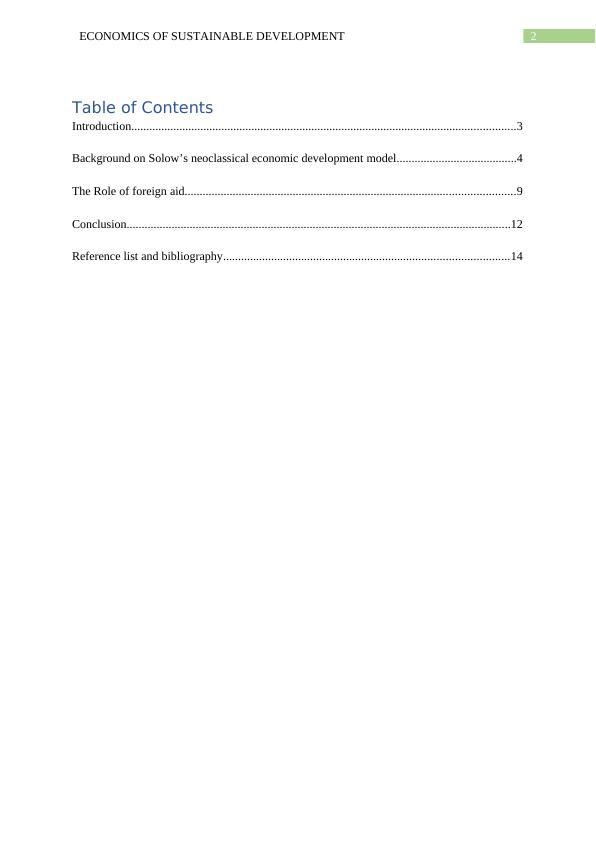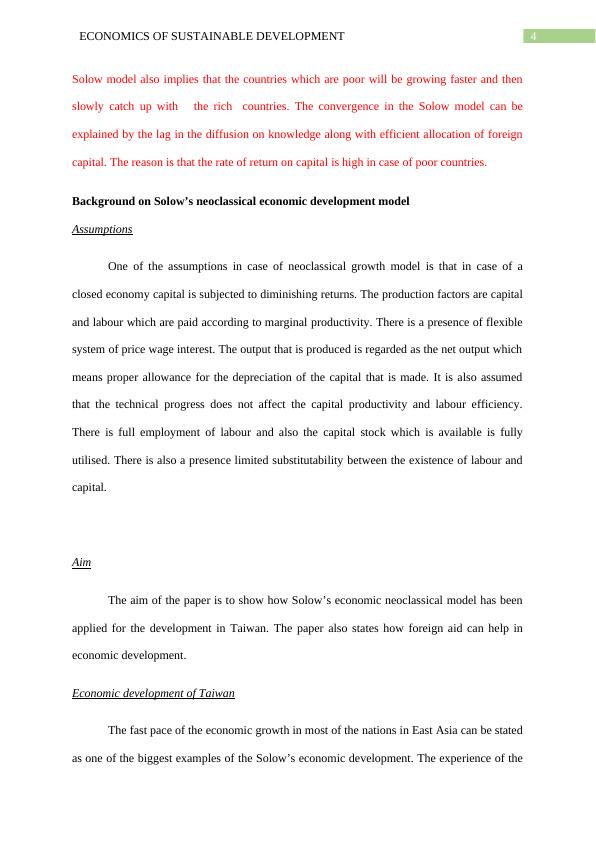Critically evaluate the Neo-classical-theory of economic growth and discuss whether foreign aid causes growth in the economy in case of developing countries
Added on 2023-04-06
15 Pages3166 Words262 Views
NAME: ADESINA OLUWAFEMI
DATE: 13-03-2019
MODULE: ECONOMICS OF SUSTAINABLE
DEVELOPMENT
COLLEGE: UNIVERSITY OF WOLVERHAMPTON
DATE: 13-03-2019
MODULE: ECONOMICS OF SUSTAINABLE
DEVELOPMENT
COLLEGE: UNIVERSITY OF WOLVERHAMPTON

2ECONOMICS OF SUSTAINABLE DEVELOPMENT
Table of Contents
Introduction................................................................................................................................3
Background on Solow’s neoclassical economic development model........................................4
The Role of foreign aid..............................................................................................................9
Conclusion................................................................................................................................12
Reference list and bibliography...............................................................................................14
Table of Contents
Introduction................................................................................................................................3
Background on Solow’s neoclassical economic development model........................................4
The Role of foreign aid..............................................................................................................9
Conclusion................................................................................................................................12
Reference list and bibliography...............................................................................................14

3ECONOMICS OF SUSTAINABLE DEVELOPMENT
Critically evaluate the Neo-classical-theory of economic growth and discuss whether foreign
aid causes growth in the economy in case of developing countries.
Introduction
The neo classical model of the economic growth in the long run have been introduced
by Robert Solow and by Trevor Swan in the year 1956. It is known to evaluate the
convergence of the economy. The neo classical growth is known to be an economic theory
which states how a steady growth rate of economy will result from a combination of labour,
technology and capital which are known to be the driving forces in the economy. The theory
of the neo classical growth model also states that short term equilibrium usually takes place
from varying amounts of labour as well as capital in the production function (Agénor and
Montiel 2015). It also states that technological change will also have a large impact on the
economy and the economic growth also cannot take place without the advances in the
technology. The neo classical model is known to be the part of Harrod Domar model which
includes the growth of the productivity.
The basic neoclassical growth model of Solow is known to be characterized by
constant returns to scale production function where the production function is denoted by Y =
F (K, L). Since investment is equal to savings therefore, K= sY and the production function is
given by Y = F(K,L). Equating both, S=sF (K,L) where L is total employment and F is
functional relationship. The Solow model of the economic growth states that during the long
run it have been found out that economies tend to converge to steady state equilibrium.
The permanent growth can only be achieved with the help of technological progress. The
growth of population and shifts in savings will only lead to level effects during long run. The
Critically evaluate the Neo-classical-theory of economic growth and discuss whether foreign
aid causes growth in the economy in case of developing countries.
Introduction
The neo classical model of the economic growth in the long run have been introduced
by Robert Solow and by Trevor Swan in the year 1956. It is known to evaluate the
convergence of the economy. The neo classical growth is known to be an economic theory
which states how a steady growth rate of economy will result from a combination of labour,
technology and capital which are known to be the driving forces in the economy. The theory
of the neo classical growth model also states that short term equilibrium usually takes place
from varying amounts of labour as well as capital in the production function (Agénor and
Montiel 2015). It also states that technological change will also have a large impact on the
economy and the economic growth also cannot take place without the advances in the
technology. The neo classical model is known to be the part of Harrod Domar model which
includes the growth of the productivity.
The basic neoclassical growth model of Solow is known to be characterized by
constant returns to scale production function where the production function is denoted by Y =
F (K, L). Since investment is equal to savings therefore, K= sY and the production function is
given by Y = F(K,L). Equating both, S=sF (K,L) where L is total employment and F is
functional relationship. The Solow model of the economic growth states that during the long
run it have been found out that economies tend to converge to steady state equilibrium.
The permanent growth can only be achieved with the help of technological progress. The
growth of population and shifts in savings will only lead to level effects during long run. The

4ECONOMICS OF SUSTAINABLE DEVELOPMENT
Solow model also implies that the countries which are poor will be growing faster and then
slowly catch up with the rich countries. The convergence in the Solow model can be
explained by the lag in the diffusion on knowledge along with efficient allocation of foreign
capital. The reason is that the rate of return on capital is high in case of poor countries.
Background on Solow’s neoclassical economic development model
Assumptions
One of the assumptions in case of neoclassical growth model is that in case of a
closed economy capital is subjected to diminishing returns. The production factors are capital
and labour which are paid according to marginal productivity. There is a presence of flexible
system of price wage interest. The output that is produced is regarded as the net output which
means proper allowance for the depreciation of the capital that is made. It is also assumed
that the technical progress does not affect the capital productivity and labour efficiency.
There is full employment of labour and also the capital stock which is available is fully
utilised. There is also a presence limited substitutability between the existence of labour and
capital.
Aim
The aim of the paper is to show how Solow’s economic neoclassical model has been
applied for the development in Taiwan. The paper also states how foreign aid can help in
economic development.
Economic development of Taiwan
The fast pace of the economic growth in most of the nations in East Asia can be stated
as one of the biggest examples of the Solow’s economic development. The experience of the
Solow model also implies that the countries which are poor will be growing faster and then
slowly catch up with the rich countries. The convergence in the Solow model can be
explained by the lag in the diffusion on knowledge along with efficient allocation of foreign
capital. The reason is that the rate of return on capital is high in case of poor countries.
Background on Solow’s neoclassical economic development model
Assumptions
One of the assumptions in case of neoclassical growth model is that in case of a
closed economy capital is subjected to diminishing returns. The production factors are capital
and labour which are paid according to marginal productivity. There is a presence of flexible
system of price wage interest. The output that is produced is regarded as the net output which
means proper allowance for the depreciation of the capital that is made. It is also assumed
that the technical progress does not affect the capital productivity and labour efficiency.
There is full employment of labour and also the capital stock which is available is fully
utilised. There is also a presence limited substitutability between the existence of labour and
capital.
Aim
The aim of the paper is to show how Solow’s economic neoclassical model has been
applied for the development in Taiwan. The paper also states how foreign aid can help in
economic development.
Economic development of Taiwan
The fast pace of the economic growth in most of the nations in East Asia can be stated
as one of the biggest examples of the Solow’s economic development. The experience of the

End of preview
Want to access all the pages? Upload your documents or become a member.
Related Documents
Solow’s Model of Unconditional Convergencelg...
|7
|1645
|88
Comparison of Endogenous Growth Model and Neo Classical Growth Modellg...
|16
|3931
|50
Economics and Business Strategylg...
|15
|3439
|83
Neo-classical Theory of Economic Growth in Developing Countrieslg...
|10
|3705
|252
Economic Growth of the Countrylg...
|9
|2812
|40
Economic Growth and Sustainable Developmentlg...
|12
|727
|74
